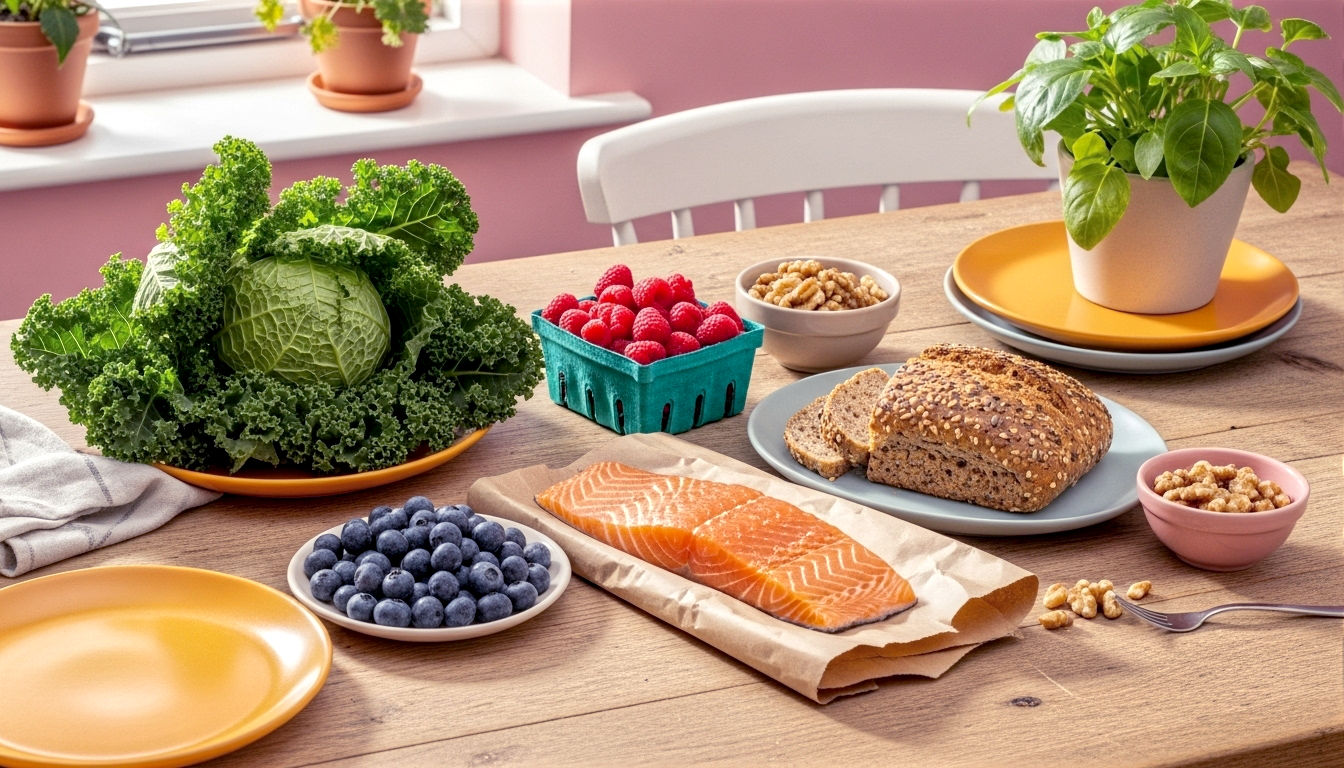Eat Smarter, Not Less: The Definitive British Guide to Nutrient-Dense Foods
Discover the secret to better health with our ultimate guide to nutrient-dense foods. Learn what they are, why they matter, and how to enjoy them in the UK.

This post may contain affiliate links. If you make a purchase through these links, we may earn a commission at no additional cost to you.
Ever feel like you’re eating all the right things but still running on empty? You’re not alone. In a world of confusing diet fads and supermarket aisles packed with promises, it’s easy to get lost. We’re told to count calories, cut carbs, and fear fat, but what if we’re missing the point? What if the secret to feeling fantastic isn’t about eating less, but about eating smarter?
Welcome to the world of nutrient density. It’s a simple idea with a powerful impact: getting the most goodness from your food. Think of it as the ultimate nutritional bargain. For every bite you take, you’re flooding your body with the vitamins, minerals, and other vital goodies it needs to thrive. This isn’t another restrictive diet; it’s a common-sense approach to eating that our grandparents would have understood, updated for our busy, modern lives.
From the rolling hills of the Scottish Highlands, where hearty oats have fuelled generations, to the vibrant market stalls of London brimming with fresh produce, the UK has a rich history of nutrient-packed foods. Yet, we’ve somehow strayed. This guide is your map back. We’ll cut through the noise, debunk the myths, and show you how to easily fill your plate with foods that pack a punch, helping you feel more energised, focused, and healthier than ever before. It’s time to stop dieting and start nourishing.
What on Earth Does ‘Nutrient-Dense’ Actually Mean?
Let’s break it down. Imagine you have two shopping bags. One is stuffed full of light, puffy crisps, and the other contains a few solid, heavy apples. Both bags might weigh the same, but the bag of apples gives you far more sustenance. Nutrient density works in a similar way, but instead of weight, we’re talking about nutrition.
A nutrient-dense food is one that is packed with beneficial nutrients like vitamins, minerals, fibre, lean protein, and healthy fats, but has relatively few calories. On the flip side, foods with low nutrient density (often called ’empty calories’) provide plenty of calories—mostly from sugar and unhealthy fats—but very little nutritional goodness.
The Core Idea: More Bang for Your Bite
Think of your daily calorie intake as a budget. Let’s say you have a budget of 2,000 calories to “spend” each day. You want to use that budget to buy the best possible nutrition for your body.
- A nutrient-dense choice: A bowl of lentil soup. For around 250 calories, you get a fantastic dose of protein to build and repair your body, fibre to keep your digestion happy, iron for energy, and B vitamins to support your nervous system. That’s a brilliant investment.
- An empty-calorie choice: A sugary doughnut. For around the same 250 calories, you get a rush of sugar, some refined flour, and unhealthy fats. You get very few vitamins or minerals. It’s a poor use of your budget that leaves your body short-changed.
It’s not about demonising certain foods—a doughnut is a lovely treat now and then!—but about understanding the difference. The goal is to make nutrient-dense foods the foundation of your diet, the everyday staples that keep you running at your best.
Meet the Nutrients: The ‘Good Stuff’ We’re Talking About
When we say ‘nutrients’, what do we mean? These are the essential tools your body needs to function. They’re broadly split into two camps:
- Macronutrients: These are the big players you need in large amounts—protein, carbohydrates, and fats. They provide energy and are the building blocks for everything from muscles to brain cells. In nutrient-dense foods, these ‘macros’ come in high-quality forms, like lean protein from fish, complex carbs from whole grains, and healthy fats from avocados.
- Micronutrients: These are the unsung heroes you need in smaller amounts but are just as vital. This group includes vitamins (like Vitamin C for your immune system and Vitamin D, the ‘sunshine vitamin’) and minerals (like calcium for strong bones and iron for healthy blood). Nutrient-dense foods are treasure troves of these micronutrients.
Beyond these, there are other brilliant compounds like antioxidants, which act like bodyguards for your cells, protecting them from damage, and fibre, the stuff that keeps your gut in tip-top shape. Foods like berries, dark leafy greens, and colourful vegetables are bursting with them.
Making nutrient-dense choices is simply about tilting the balance in your favour, ensuring every meal is an opportunity to fuel your body with the best tools available.
A Quick Stroll Through Britain’s Nutritional History
Our relationship with nutrient-dense food isn’t new; it’s a story woven into the very fabric of British history. For centuries, what we ate was dictated by the seasons and the land. There were no processed foods or year-round strawberries. People ate what was available, and much of it was naturally nutrient-dense.
The Age of Real Food: From Pottage to Ploughman’s
Before the Industrial Revolution, the average Brit’s diet was simple but effective. Pottage, a thick stew of grains, vegetables, and occasionally meat, was a daily staple. It might not sound glamorous, but it was a nutrient-dense powerhouse, simmering away over the fire all day. People ate whole grains like oats and barley, seasonal vegetables from their own patches—leeks, onions, cabbages—and protein from peas and beans.
Meat was a luxury for many, but when available, no part was wasted. This ‘nose-to-tail’ eating provided a wide range of nutrients, from the iron in liver to the collagen in bones (used for broths). This was a diet built on necessity, but it was inherently balanced and packed with goodness.
The Great Shift: Industrialisation and the Rise of Processed Food
The 19th and 20th centuries changed everything. As people flocked to cities to work in factories, their connection to the land—and their food—was broken. Convenience became king.
- The White Loaf: The invention of roller milling in the late 1800s allowed for the mass production of fine, white flour. It had a longer shelf life and was seen as a status symbol, a far cry from the coarse, brown bread of the poor. But in stripping away the bran and germ, vital nutrients like fibre, B vitamins, and iron were lost.
- The Sugar Rush: Sugar, once a costly luxury, became cheap and abundant. It was added to everything, from tea to tinned puddings, providing a quick energy hit for weary workers but offering zero nutritional value.
- Wartime Wisdom: Curiously, some of our healthiest periods came during times of hardship. During the Second World War, rationing forced a return to simpler, more nutrient-dense eating. The ‘Dig for Victory’ campaign encouraged everyone to grow their own vegetables. With meat, sugar, and fat strictly limited, people ate more potatoes, seasonal veg, and wholemeal bread. Public health actually improved during this time, a powerful testament to the benefits of a nutrient-focused diet.
The Modern Era: Convenience, Confusion, and a Return to Roots
After the war, the food industry exploded. Supermarkets arrived, offering unprecedented choice and convenience. Frozen ready meals, sugary breakfast cereals, and fizzy drinks became staples in the British shopping basket. We gained convenience but lost nutrient density along the way.
Today, we’re at a crossroads. We face rising rates of diet-related health issues, yet there’s also a growing movement of people wanting to reconnect with real food. Farmers’ markets are bustling, allotments are in high demand, and there’s a renewed interest in cooking from scratch. We are starting to remember the wisdom of our ancestors: that true health comes not from a packet, but from the ground. Understanding nutrient density is the key to unlocking that wisdom once more.
The A-List: Britain’s Top Nutrient-Dense Foods
Ready to stock your kitchen with nutritional superstars? The good news is that you don’t need exotic, expensive ingredients flown in from halfway across the world. Many of the most nutrient-dense foods are humble, affordable, and readily available right here in the UK.
Here’s a look at some of the best food groups to focus on, packed with examples you can find in any local supermarket or market.
1. Dark Leafy Greens: The Unsung Heroes
If there were a royal family of vegetables, dark leafy greens would be sitting on the throne. They are incredibly low in calories but bursting with vitamins and minerals.
- Kale: This robust green is a true nutritional powerhouse. It’s loaded with Vitamin K (essential for blood clotting and bone health), Vitamin C (for a strong immune system), and antioxidants. A British winter favourite, it’s perfect in soups, stews, or crisped up in the oven.
- Spinach: Famous for its iron content, spinach also provides heaps of Vitamin A (for vision and skin) and folate (crucial for cell growth). It wilts down to almost nothing, so it’s easy to chuck a large handful into curries, pasta sauces, or smoothies.
- Watercress: This peppery leaf has a long history in Britain and was a staple for working-class families. It’s exceptionally rich in nutrients and is even being studied for its potential health benefits. Perfect in salads and sandwiches.
2. The Berry Brigade: Small but Mighty
Berries are nature’s sweet treats, and they are packed with fibre and disease-fighting antioxidants called anthocyanins, which give them their vibrant colours.
- Blackcurrants: These tart British berries have one of the highest Vitamin C contents of any fruit, far more than oranges. They are fantastic for supporting your immune system.
- Blueberries: A global favourite, blueberries are antioxidant superstars. They are great for brain health and are delicious sprinkled on porridge or yoghurt.
- Raspberries & Strawberries: Classic British summertime fruits, they are high in fibre and Vitamin C. Always choose British-grown when in season for the best flavour and nutrient profile.
3. Oily Fish: Brain Food from the Sea
Oily fish are celebrated for their high content of omega-3 fatty acids, a type of healthy fat that is crucial for brain function, heart health, and reducing inflammation in the body. The government recommends we eat at least one portion a week.
- Salmon: Especially Scottish salmon, which is renowned for its quality. It’s a fantastic source of omega-3s and high-quality protein.
- Mackerel: A wonderfully sustainable and affordable option. Smoked mackerel is a classic British delicacy and makes for a quick, nutritious lunch with a bit of horseradish sauce.
- Sardines: Don’t overlook the humble tinned sardine! They are incredibly nutrient-dense, providing not just omega-3s but also calcium (from their tiny, edible bones) and Vitamin D.
4. Cruciferous Vegetables: The Clever Cabbages
This family of vegetables is named for its cross-shaped flowers and includes many British staples. They are known for being rich in fibre, vitamins, and sulphur-containing compounds that are thought to have health-protective properties.
- Broccoli: A true superfood, broccoli is loaded with Vitamin C, Vitamin K, and fibre. Steam it, roast it, or stir-fry it—just try not to boil it to death, as this can destroy some of the nutrients.
- Cauliflower: Enjoying a trendy revival, cauliflower is a versatile veg that’s high in Vitamin C and folate. It can be roasted whole, mashed as a potato substitute, or even made into a ‘pizza’ base.
- Brussels Sprouts: More than just a Christmas dinner side-dish! Sprouts are packed with nutrients. Roasting them with a little olive oil brings out their sweet, nutty flavour.
5. Pulses and Legumes: The Thrifty Powerhouses
Lentils, beans, and chickpeas are some of the most nutrient-dense and budget-friendly foods on the planet. They offer a fantastic combination of plant-based protein, complex carbohydrates, and soluble fibre, which is great for heart health and keeping you feeling full.
- Lentils: Red, green, or brown, lentils are brilliant in soups, dahls, and shepherd’s pie fillings. They are a great source of iron and folate.
- Chickpeas: The star of hummus, chickpeas are also wonderful in curries or roasted until crispy for a healthy snack. They provide a good dose of manganese, a mineral important for bone health.
- Kidney Beans: A key ingredient in chilli con carne, kidney beans are rich in fibre and protein.
6. Nuts and Seeds: A Handful of Goodness
Nuts and seeds are concentrated sources of healthy fats, protein, fibre, and essential minerals.
- Walnuts: The only nut to contain a significant amount of plant-based omega-3s. Their shape is even a clue—they’re great for your brain!
- Flaxseeds (Linseeds): These tiny seeds are another excellent source of omega-3s and a type of fibre called lignans. Buy them ground or grind them yourself to get the most benefit.
- Pumpkin Seeds: Rich in magnesium, a mineral that many of us don’t get enough of, which is involved in over 300 processes in the body, including energy production and muscle function.
7. Whole Grains: The Superior Carb
Unlike their refined cousins (like white bread and pasta), whole grains contain the entire grain kernel—bran, germ, and endosperm. This means they retain all their fibre, B vitamins, and minerals.
- Oats: The quintessential Scottish breakfast! Porridge made with whole rolled oats provides a slow release of energy to keep you going all morning. Oats contain a special type of soluble fibre called beta-glucan, which is proven to help lower cholesterol.
- Barley: A wonderfully nutty grain that’s fantastic in stews and soups (like a classic Scotch broth). It’s another great source of beta-glucan.
- Quinoa: While not native to the UK, quinoa is now widely grown here. It’s a ‘complete protein’, meaning it contains all nine essential amino acids, making it an excellent choice for vegetarians and vegans.
Putting It All Together: Building a Nutrient-Dense Plate
Understanding which foods are nutrient-dense is the first step. The next is learning how to weave them into your daily meals. The brilliant thing is, it doesn’t require a radical overhaul or a celebrity chef’s skills. It’s about making simple, effective swaps and additions.
The Plate Model: A Simple Visual Guide
Forget complicated calorie counting or weighing your food. A much simpler way to ensure a nutrient-dense meal is to use the ‘plate model’. Imagine your dinner plate and divide it up:
- Half Your Plate (50%): Non-Starchy Vegetables and Salads. This is where you load up on colour. Think broccoli, kale, spinach, peppers, tomatoes, cauliflower, and leafy greens. This section provides a massive dose of vitamins, minerals, and fibre for very few calories.
- One Quarter of Your Plate (25%): High-Quality Protein. This is essential for building and repairing tissues and keeping you feeling full and satisfied. Choose from oily fish, chicken, lean red meat, eggs, or plant-based options like lentils, chickpeas, or tofu.
- One Quarter of Your Plate (25%): Complex Carbohydrates. These are your primary energy source. Choose whole grain varieties to get the added benefit of fibre and B vitamins. Think a small portion of brown rice, quinoa, wholewheat pasta, or a baked sweet potato.
What about fats? Healthy fats are crucial, so don’t forget to include them. This might be the olive oil you use for roasting your veg, the avocado in your salad, or the nuts sprinkled over your porridge.
Simple Swaps for a Big Nutritional Upgrade
Here are some easy exchanges you can make to instantly boost the nutrient density of your meals:
| Instead of This… | Try This Nutrient-Dense Swap… | Why It’s Better |
|---|---|---|
| Sugary Breakfast Cereal | A bowl of porridge with berries and seeds | Provides slow-release energy, fibre, vitamins, and healthy fats instead of a sugar crash. |
| White Bread Sandwich | Wholemeal bread sandwich packed with salad | Boosts fibre, B vitamins, and micronutrients. More filling, too! |
| Crisps as a Snack | A handful of almonds or walnuts | Swaps empty calories for protein, healthy fats, and minerals like magnesium. |
| Creamy, Rich Sauces | Tomato-based or vegetable-packed sauces | Cuts down on saturated fat and calories while adding vitamins and antioxidants. |
| Fizzy Drinks or Squash | A glass of water with a slice of lemon | Hydrates you without adding any sugar or artificial sweeteners. |
| White Rice | Brown rice or quinoa | Increases fibre content, which is better for digestion and blood sugar control. |
A Day on a Plate: What It Looks Like in Practice
Here’s a sample day of nutrient-dense eating. Notice how it’s not about deprivation—it’s full of delicious, satisfying food.
- Breakfast: A bowl of porridge made with whole milk or a plant-based alternative, topped with a handful of raspberries, a sprinkle of flaxseeds, and a few walnuts.
- Lunch: A large mixed salad with rocket and watercress, cherry tomatoes, cucumber, and peppers. Topped with a fillet of smoked mackerel or a tin of chickpeas, and dressed with extra virgin olive oil and lemon juice.
- Dinner: A chicken and vegetable stir-fry with broccoli, pak choi, and red onions, using a sauce made from soy sauce, ginger, and garlic. Served with a small portion of brown rice.
- Snacks: A crisp apple with a spoonful of peanut butter, a small pot of plain Greek yoghurt, or a handful of pumpkin seeds.
This is just an example. The key is variety. Eating a wide range of different coloured fruits and vegetables ensures you’re getting a broad spectrum of all the vitamins and minerals your body needs. Eat the rainbow!
Debunking Common Myths and Misconceptions
The world of nutrition is full of confusing and often contradictory advice. Let’s clear up some of the most common myths surrounding healthy eating and nutrient density.
Myth 1: “All calories are equal.”
The Truth: This is one of the biggest fallacies in nutrition. While it’s true that a calorie is a unit of energy, the source of that calorie matters enormously to your body.
Think back to our budget analogy. 200 calories from a handful of almonds provides healthy fats, protein, fibre, and magnesium. Your body can put all of that to good use. 200 calories from a fizzy drink provides a large dose of sugar and nothing else. This sugar spike can play havoc with your blood sugar levels, leaving you feeling tired and hungry again soon after. Your body processes these two sources of calories in completely different ways. Focus on the quality of your calories, not just the quantity.
Myth 2: “Healthy food is too expensive.”
The Truth: While some so-called ‘superfoods’ can be pricey, a nutrient-dense diet can actually be very budget-friendly. The key is to build your meals around affordable staples.
- Embrace pulses: Dried lentils, beans, and chickpeas are incredibly cheap, filling, and nutritious.
- Buy seasonal: Fruit and vegetables are always cheaper and tastier when they are in season in the UK. Think apples and squashes in autumn, and berries and courgettes in summer.
- Frozen is fantastic: Frozen fruits and vegetables are just as nutritious as fresh—sometimes even more so, as they are frozen at peak ripeness. They are often cheaper and reduce food waste as you only use what you need.
- Don’t fear the tinned aisle: Tinned tomatoes, oily fish, and beans are convenient, long-lasting, and packed with nutrients. Just choose options in water or tomato sauce rather than brine or oil.
Myth 3: “Carbs and fats are the enemy.”
The Truth: This is a harmful oversimplification. Your body needs both carbohydrates and fats to function. The problem isn’t the macronutrient itself, but the type and quality.
- Carbohydrates: Refined carbs (white bread, pastries, sugary snacks) are the ones to limit. Complex carbs (whole grains, vegetables, pulses) are fantastic. They provide sustained energy and vital fibre.
- Fats: Trans fats and excessive saturated fats found in processed foods are unhealthy. But healthy fats (monounsaturated and polyunsaturated fats) found in olive oil, avocados, nuts, and oily fish are essential for brain health, hormone production, and absorbing certain vitamins.
It’s not about cutting out entire food groups; it’s about choosing the most nutrient-dense options within each group.
Myth 4: “You need expensive supplements to be healthy.”
The Truth: For most people, a well-balanced, nutrient-dense diet provides all the vitamins and minerals they need. Supplements cannot replace a healthy diet. Food contains a complex synergy of nutrients, fibre, and other compounds that work together in a way that a pill simply can’t replicate.
There are some exceptions. The NHS recommends that everyone in the UK considers taking a daily Vitamin D supplement during the autumn and winter months, as we can’t make enough from our weak sunlight. Certain groups, like pregnant women or those on specific restricted diets, may also need other supplements. But for the general population, the focus should always be food first. Always speak to your GP before starting any new supplements.
The Future of Food: Trends and What’s Next for Nutrition
Our understanding of nutrition is constantly evolving, and the focus is shifting ever more towards the principles of nutrient density, personalisation, and sustainability.
The Rise of Personalised Nutrition
We’re moving away from one-size-fits-all dietary advice. Emerging science is showing how our individual genetics, lifestyle, and even the unique collection of microbes in our gut (our microbiome) can influence how we respond to different foods.
In the future, you might get dietary recommendations tailored specifically to you. But the core principle will remain the same: whatever your personal needs, fulfilling them with nutrient-dense whole foods will always be the best strategy.
Gut Health: The Second Brain
The health of our gut microbiome has become one of the most exciting areas of nutritional research. The trillions of bacteria living in our digestive system are now known to play a crucial role in everything from our immune system and mental health to our weight.
What do these friendly microbes love to eat? Fibre, especially from a wide variety of plant-based, nutrient-dense foods. Eating a diverse ‘rainbow’ of vegetables, fruits, whole grains, and legumes is one of the best ways to cultivate a healthy and resilient gut microbiome. Fermented foods like live yoghurt, kefir, and sauerkraut can also be beneficial.
Sustainability: Healthy Planet, Healthy People
The conversation around food is no longer just about our health; it’s about the health of our planet. A nutrient-dense way of eating naturally aligns with a more sustainable one.
- Eating more plants: Shifting towards a more plant-centric diet, rich in vegetables, fruits, and pulses, reduces our carbon footprint.
- Eating local and seasonal: This reduces ‘food miles’ and supports British farmers.
- Reducing food waste: Focusing on whole foods and cooking from scratch often means we buy only what we need, cutting down on waste.
The future of healthy eating is about recognising this powerful connection. When we choose foods that nourish our bodies, we are often also choosing foods that are kinder to the environment.
Conclusion: Your Journey to a More Nourished Life
Navigating the world of food and nutrition can feel overwhelming, but the principle of nutrient density is a beautifully simple compass to guide you. It’s not about restriction, guilt, or chasing the latest fad. It’s about a positive, joyful approach to eating. It’s about celebrating real, wholesome food and the incredible things it can do for your body and mind.
By making small, conscious choices every day—swapping white bread for wholemeal, adding a handful of spinach to your sauce, snacking on nuts instead of crisps— you are investing in your long-term health and wellbeing. You are choosing energy over lethargy, strength over sickness, and vitality over vulnerability.
So, the next time you sit down for a meal, look at your plate and ask a simple question: “Is this food working for me?” Fill your life with foods that give back more than they take. Your body will thank you for it.
Further Reading & Reputable Resources
For trusted, evidence-based information, always turn to reliable sources. Here are some of the best in the UK:
- The NHS Website: The Eatwell Guide provides the UK’s official dietary recommendations.
- The British Nutrition Foundation: A leading authority on nutrition science, offering accessible information for the public. nutrition.org.uk
- The British Dietetic Association (BDA): The professional body for dietitians in the UK, providing excellent Food Fact Sheets on a wide range of topics.






